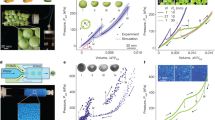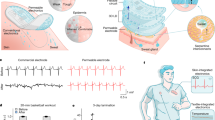Abstract
Many biological surfaces in both the plant and animal kingdom possess unusual structural features at the micro- and nanometre-scale that control their interaction with water and hence wettability1,2,3,4,5. An intriguing example is provided by desert beetles, which use micrometre-sized patterns of hydrophobic and hydrophilic regions on their backs to capture water from humid air6. As anyone who has admired spider webs adorned with dew drops will appreciate, spider silk is also capable of efficiently collecting water from air. Here we show that the water-collecting ability of the capture silk of the cribellate spider Uloborus walckenaerius is the result of a unique fibre structure that forms after wetting, with the ‘wet-rebuilt’ fibres characterized by periodic spindle-knots made of random nanofibrils and separated by joints made of aligned nanofibrils. These structural features result in a surface energy gradient between the spindle-knots and the joints and also in a difference in Laplace pressure, with both factors acting together to achieve continuous condensation and directional collection of water drops around spindle-knots. Submillimetre-sized liquid drops have been driven by surface energy gradients7,8,9 or a difference in Laplace pressure10, but until now neither force on its own has been used to overcome the larger hysteresis effects that make the movement of micrometre-sized drops more difficult. By tapping into both driving forces, spider silk achieves this task. Inspired by this finding, we designed artificial fibres that mimic the structural features of silk and exhibit its directional water-collecting ability.
This is a preview of subscription content, access via your institution
Access options
Subscribe to this journal
Receive 51 print issues and online access
$199.00 per year
only $3.90 per issue
Buy this article
- Purchase on Springer Link
- Instant access to full article PDF
Prices may be subject to local taxes which are calculated during checkout





Similar content being viewed by others
References
Feng, L. et al. Super-hydrophobic surfaces: from natural to artificial. Adv. Mater. 14, 1857–1860 (2002)
Gao, X. F. & Jiang, L. Water-repellent legs of water striders. Nature 432, 36 (2004)
Blossey, R. Self-cleaning surfaces—virtual realities. Nature Mater. 2, 301–306 (2003)
Sun, T. L., Feng, L., Gao, X. F. & Jiang, L. Bioinspired surfaces with special wettability. Acc. Chem. Res. 38, 644–652 (2005)
Li, X. M., Reinhoudt, D. & Crego-Calama, M. What do we need for a superhydrophobic surface? A review on the recent progress in the preparation of superhydrophobic surfaces. Chem. Soc. Rev. 36, 1350–1368 (2007)
Parker, A. R. & Lawrence, C. R. Water capture by a desert beetle. Nature 414, 33–34 (2001)
Chaudhury, M. K. & Whitesides, G. M. How to make water run uphill. Science 256, 1539–1541 (1992)
Daniel, S., Chaudhury, M. K. & Chen, J. C. Fast drop movements resulting from the phase change on a gradient surface. Science 291, 633–636 (2001)
Daniel, S., Sircar, S., Gliem, J. & Chaudhury, M. K. Ratcheting motion of liquid drops on gradient surfaces. Langmuir 20, 4085–4092 (2004)
Lorenceau, É. & Quéré, D. Drops on a conical wire. J. Fluid Mech. 510, 29–45 (2004)
Vollrath, F. & Porter, D. Spider silk as archetypal protein elastomer. Soft Matter 2, 377–385 (2006)
Vollrath, F. et al. Compounds in the droplets of the orb spider’s viscid spiral. Nature 345, 526–528 (1990)
Liu, Y., Shao, Z. & Vollrath, F. Relationships between supercontraction and mechanical properties of spider silk. Nature Mater. 4, 901–905 (2005)
Vollrath, F. Strength and structure of spiders’ silks. Rev. Mol. Biotechnol. 74, 67–83 (2000)
Vollrath, F. & Edmonds, D. T. Modulation of the mechanical properties of spider silk by coating with water. Nature 340, 305–307 (1989)
Edmonds, D. T. & Vollrath, F. The contribution of atmospheric water vapour to the formation and efficiency of a spider’s capture web. Proc. R. Soc. Lond. B 248, 145–148 (1992)
Backer, N. et al. Molecular nanosprings in spider capture-silk threads. Nature Mater. 2, 278–283 (2003)
Peter, H. M. The spinning apparatus of Uloboridae in relation to the structure and construxtion of capture threads (Arachnida, Araneida). Zoomorphology 104, 96–104 (1984)
Porter, D. & Vollrath, F. Nanoscale toughness of spider silk. Nanotoday 2, 6 (2007)
Emile, O., Floch, A. L. & Vollrath, F. Biopolymers: shape memory in spider draglines. Nature 440, 621 (2006)
Yang, J., Yang, Z., Chen, C. & Yao, D. Conversion of surface energy and manipulation of a single droplet across micropatterned surfaces. Langmuir 24, 9889–9897 (2008)
Fang, G., Li, W., Wang, X. & Qiao, G. Droplet motion on designed microtextured superhydrophobic surfaces with tunable wettability. Langmuir 24, 11651–11660 (2008)
Wenzel, R. N. Resistance of solid surface to wetting by water. Ind. Eng. Chem. 28, 988–994 (1936)
Quéré, D. Wetting and roughness. Annu. Rev. Mater. Res. 38, 16.1–16.29 (2008)
Zheng, Y. M., Gao, X. F. & Jiang, L. Directional adhesion of superhydrophobic butterfly wings. Soft Matter 3, 178–182 (2007)
Gau, H., Herminghaus, S., Lenz, P. & Lipowsky, R. Liquid morphologies on structured surfaces: from microchannels to microchips. Science 283, 46–49 (1999)
Yoshimitsu, Z., Nakajima, A., Watanabe, T. & Hashimoto, K. Effects of surface structure on the hydrophobicity and sliding behavior of water droplets. Langmuir 18, 5818–5822 (2002)
Acknowledgements
We thank the State Basic Research Program of China (2007CB936403), the Key Program in the National Natural Science Foundation of China (119030601101), and the Knowledge Innovation Program in the Chinese Academy of Sciences (2A200522222200301).
Author Contributions Y. Zheng, H.B., Z.H. and X.T. performed the experiments. Y. Zheng and Z.H. worked on the water collection of natural spider silks, H.B. and X.T. worked on the fabrication and water collection of artificial spider silk. Y. Zheng and H.B. conducted the control experiments. Y. Zheng, H.B., Y. Zhao and L.J. collected and analysed the data and proposed the mechanism of directional water collection on spider silk. Y. Zheng, F.-Q.N., Y. Zhao., J.Z. and L.J. wrote the text. L.J. conceived the project and designed the experiments.
Author information
Authors and Affiliations
Corresponding authors
Ethics declarations
Competing interests
The authors declare no competing financial interests.
Supplementary information
Supplementary Information
This file contains Supplementary Methods, Supplementary Figures S1-S8 with Legends, a Supplementary Discussion and Supplementary References. (PDF 1593 kb)
Supplementary Movie 1
This movie shows the in-situ observation of directional water collection on the capture silk of a cribellate spider. Note that the condensing drops move quickly from the joint to the spindle-knot of spider silk. (MOV 390 kb)
Rights and permissions
About this article
Cite this article
Zheng, Y., Bai, H., Huang, Z. et al. Directional water collection on wetted spider silk. Nature 463, 640–643 (2010). https://doi.org/10.1038/nature08729
Received:
Accepted:
Issue Date:
DOI: https://doi.org/10.1038/nature08729
This article is cited by
-
Surface-engineered microfibers provide liquid transport flexibility
Nature Chemical Engineering (2024)
-
Durable Janus membrane with on-demand mode switching fabricated by femtosecond laser
Nature Communications (2024)
-
Predicting droplet detachment force: Young-Dupré Model Fails, Young-Laplace Model Prevails
Communications Physics (2024)
-
Self-encapsulated ionic fibers based on stress-induced adaptive phase transition for non-contact depth-of-field camouflage sensing
Nature Communications (2024)
-
Flexible hemline-shaped microfibers for liquid transport
Nature Chemical Engineering (2024)
Comments
By submitting a comment you agree to abide by our Terms and Community Guidelines. If you find something abusive or that does not comply with our terms or guidelines please flag it as inappropriate.



